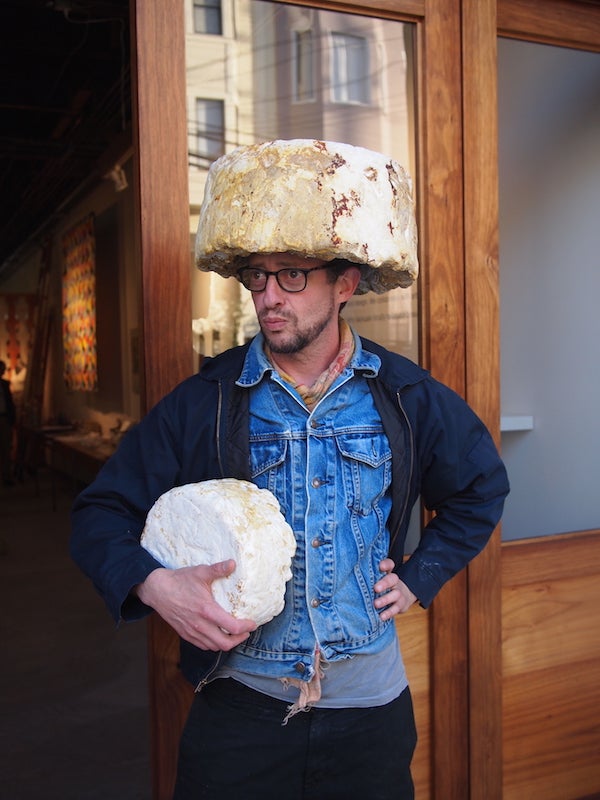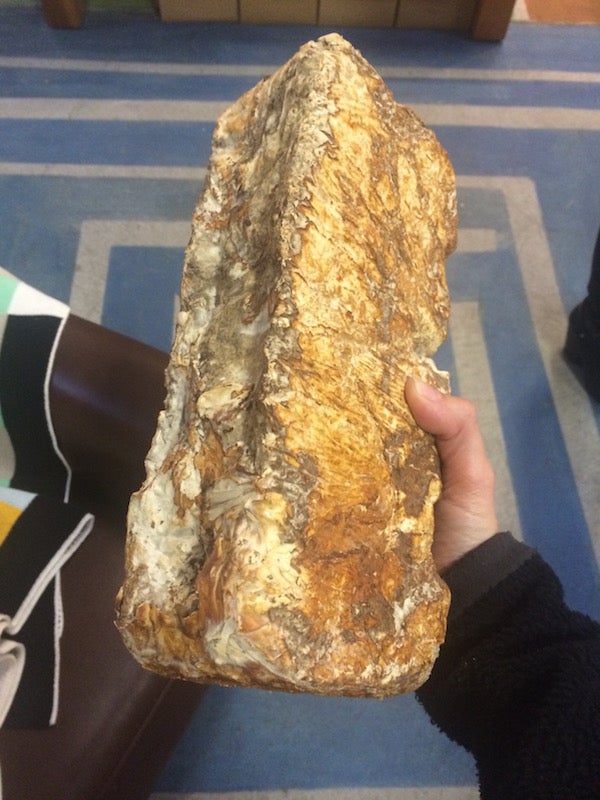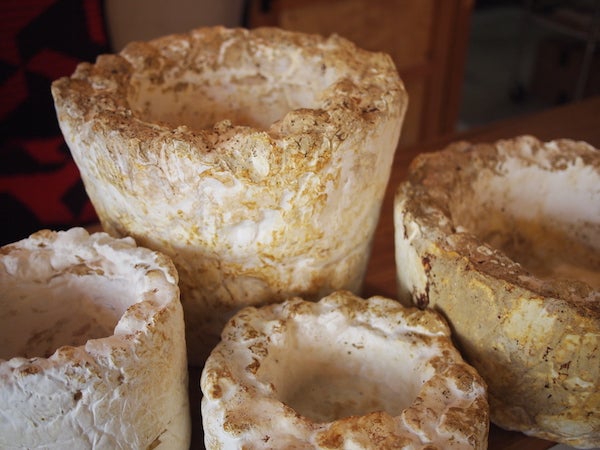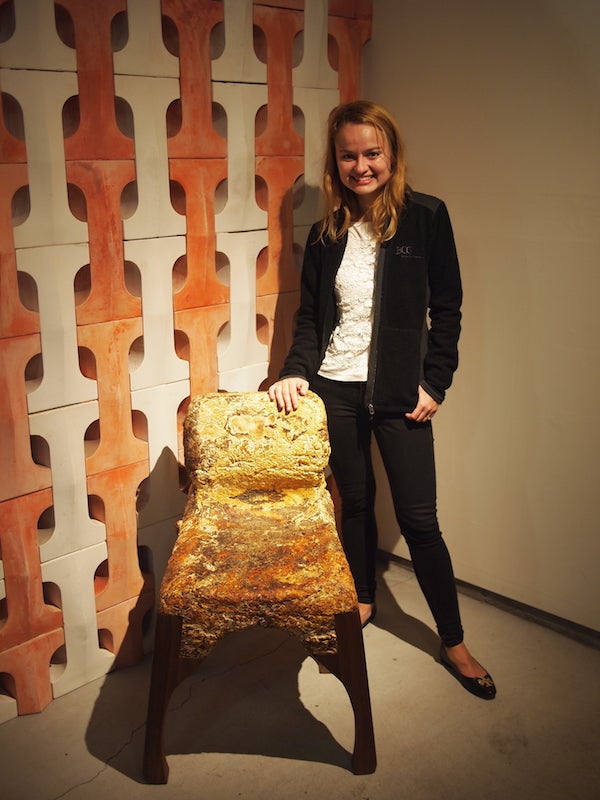This article was published in Scientific American’s former blog network and reflects the views of the author, not necessarily those of Scientific American
The official motto of the Fungus Federation of Santa Cruz, California is “When it rains, it spores.” Through much of the year, many fungal species lurk underground in webs of fibers called “mycelium,” invisible to fungus fanatics above. But with a good spritzing, mushrooms—the reproductive part of the fungus—burst through the surface, and gathering begins. If gatherers only knew that an inventor named Phil Ross could furnish their homes with mushrooms all year long.
I first learned of Ross while visiting a mushroom exhibit at the Santa Cruz Museum of Art and History. An unusual blend of Flintstone aesthetic and1960s chic, his chairs and tables are built from a mushroom composite that promises visitors a new, sustainable alternative to wood, plastic, and other materials. These mushroom-based products are all natural, toxin free, and compostable. Ross has co-founded a company, Mycoworks, to produce them, as part of a small movement to make mushroom materials mainstream. But even after years of research, it’s unclear whether mushrooms will stay hidden in obscurity, or whether they’ll burst into the mainstream.
“It looks a lot like alien surgery,” Ross said of experimenting with mushroom structures. Even after years of building, the chef-turned-artist-turned-inventor says he’s still learning a lot about how to produce his materials. Pocked with blotches of brown and tan, the final product resembles a weathered rock, but feels only slightly rougher than cardboard.
On supporting science journalism
If you're enjoying this article, consider supporting our award-winning journalism by subscribing. By purchasing a subscription you are helping to ensure the future of impactful stories about the discoveries and ideas shaping our world today.

Artist, inventor and furniture make Phil Ross, wearing one of his mushroom "vessels."
Ross begins with a carbon-based agricultural byproduct, like cornhusks or sawdust, and adds a bit of mycelium tissue. The culture comes from Ganoderma lucidum, a mushroom that forms chestnut-colored saucers on surfaces it colonizes. Most importantly, it grows at room temperature, ideal for a lab aiming to keep energy costs low.
The mycelium feeds on the sawdust over a couple of weeks and forms a vast web of fibers. Ross then transfers the growing structure to a mold, and the fibers grow to fill the form of the container, be it brick- or chair-shaped. Next, Ross pops the structure into an oven to denature proteins and kill the fungus. (A similar process prepares furniture made from wood.) He adds wooden legs to furniture for structural support. The finished product consists of a mushroom composite containing chitin–the same material that adds structure to beetle shells. It’s also edible, Ross told me, should I start to feel desperate.
By finagling with nutrients and other factors, the material can be as hard as balsa wood or as soft as cork. Ross focuses on bricks and furniture, but a New York-based company, Ecovative, has developed mushroom-based alternatives to fiberboard and foam for packaging. Dell uses the latter to ship laptops.

Mushroom brick. Image by Natalie Jacewicz
Sonia Travaglini, a doctoral researcher in mechanical engineering at the University of California, Berkeley, has spent the past three years studying Ross’ material, stretching and squishing mushroom bricks and recording results. She also tests traits that could impact adoption, like odor. “People thought it was woodsy,” Travaglini said, but not in a bad way. She envisions scaling production to replace foams produced with crude oil and wood produced by logging.
If mushrooms are a miracle material, why can’t we buy mushroom sofas at Ikea? I asked a couple of biomaterial specialists for insight.
Salmaan Craig, an engineer and biomaterials lecturer at the Harvard School of Design, said the material’s wide range of applications seems “very promising,” particularly as a brick-like building material. But he claimed the real challenge lies in making the material last durably outside without dinging its sustainability. (Many outdoor materials require long periods of baking at high temperatures, or adding non-sustainable components.)
“There’s a lot of skepticism around products that are new,” added Anjanette Green, a materials specialist at Environmental Building Strategies, a consultancy that helps manage sustainable building projects.
Cost doesn’t help. Green’s team has calculated that mushroom materials can cost 40 percent more than traditional alternatives. A client once came close to using mushroom insulation but balked because the material was too expensive.
Still, Green says the material holds great promise. “I think it stands head and shoulders above other products,” she said. “It solves so many problems.” While many other composite materials need carcinogenic resins to hold them together, mushroom composites hold together naturally. This environmental benefit has economic payoff. Construction and maintenance teams don’t need to wear hazmat suits to work with the material, nor do they require toxic chemical training.

Vessels forged from fungi
For now, cities made of mushrooms seem far away. Only one retailer sells Ross’ products directly to consumers—the Residence Workshop in San Francisco. I visited the shop to sit in a chair for myself. My under-furnished apartment won’t be sporting any mushroom wares soon; a stool sells for $300, a chair for $3,000.
That money won’t buy comfort. The chair’s uneven surface and lack of cushioning reminded me that I wasn’t so much sitting as trying out a potential vision of the future, one with mushroom-insulated walls and no foam peanuts. How much would I pay to vouch for a belief in a greener future that might not materialize? Thirteen of the 14 stools have sold, and a $250 vessel now sits in a one of Twitter’s office cafés. But it’s difficult to say if the purchasers share Ross’ dream for a sustainable world or merely appreciate novelty. Even if they do share his goals, it’s difficult to say that a mushroom chair is the best way $3,000 could fund a greener future. Taken alone, the pieces seem like sustainability totems—rich in symbolism, poor in impact.

The author with a $3000 mushroom chair
But I can’t completely dismiss the furniture’s potential to incite a mushroom revolution. It’s easy to toss packaging away without considering its material, but it’s impossible to do the same with Ross’ chairs. Craig of the Harvard School of Design said of mushroom technology, “If it’s going to have a real impact, it should be visual and celebrated.”
From this perspective, the mushroom chairs might be beacons to the dream of a mushroom future. At the very least, they alerted me that such a dream existed.
Natalie Jacewicz is a journalist in the science communication program at the University of California, Santa Cruz. She holds a bachelor's degree in evolutionary biology from Harvard. For more of her work, visit her website or follow her on Twitter @NatalieJacewicz.